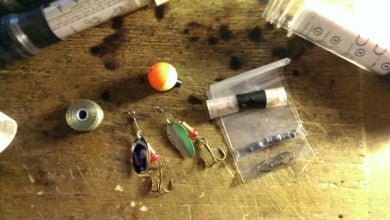An Unconventional and Compact Fishing Kit
AllOutdoor Staff 05.14.14

This is a guest post by outdoorsman Josh Perlmutter. His pocket survival kit is available for $10 on his Etsy store, 1stLineSurvival.

I’ve always been a fan of fishing without a traditional pole and gear. I prefer other methods such as a film-canister type survival kit and reel, wrapping line around a water bottle, or just using a plain old spool of line and a hook. I wanted a weightless kit that I could carry in my pants or shirt pocket, was self-contained with both line and tackle, quick to deploy, easy to use, reliable, and fun.
The first kit I made was an attempt to copy my old film canister fishing kit. The film can kit was an old 35mm film canister that held tackle inside and had line wrapped around the outside. The user would cast the line off the kit by flicking the wrist and holding onto the canister. The main problems with this kit were the size and the durability of the canister itself. It was hard to hold onto while casting because it was so small. If you landed a fish of any size, the canister was almost sure to buckle from the ensuing fight to the shore. A few times the canister opened up in my pack after being knocked around or smashed into things.
I went one size bigger and started using an old prescription pill container. That worked alright. It was still small and hard to hold onto, but it didn’t buckle under pressure or open up in my pack.
It wasn’t until I was watching an army video on YouTube and saw the medic pull out a plastic tube that contained needles that I had a new idea. The plastic tube looked tough as nails, and it had what looked like a soda bottle top on it. Another quick search yielded “tube vaults,” which in reality were 2-liter soda bottle preforms. A preform is what a 2-liter bottle is before it becomes a 2-liter bottle. Picture a plastic “cigar tube”-sized test tube made out of hard plastic; that’s a preform. Normally, preforms are screwed into a machine, heated, and “blown up” into 2-liter bottles.
Another quick Google search landed me with 1-liter bottle preforms–the same size as the 2-liter bottles, only lighter in weight as they use less plastic for the smaller bottle. The size was perfect. It fit comfortably into my pants/shirt pockets and was virtually indestructible–you can practically jump on them without breaking–and it had a screw top so there is no way it can accidentally open from being tossed around.
Now that I had my container, I needed to increase traction for the line. Just tying line onto the tube wasn’t going to work. When you cast the line just on the tube and land a fish, the fight will pull the line off the tube, making it impossible to reel in your catch. The tube’s surface was too smooth, the line had no traction, so when you pulled it, it would just unwind. I solved this problem by adding a section of rubber to the end of the tube where the line reels in. Now, with a fish on the line, the rubber provided surface traction on the tube that allows you to reel in the fish.
I drilled a hole in the cap and added a lanyard. This was so you could cast the kit and not have to worry about it slipping out of your hand. It also allows you to clip it onto the exterior of your pack or belt or hang it out of your pocket. I stuffed the inside of the tube with some hooks, sinkers, synthetic maggots for bait, a ¾” bobber, a couple spinner lures, and a 60 ft. bobbin of 15 lb. nylon thread for some emergency fishing line. The kit was ready for trials.
I tested it on a fishing trip with four friends. They all had poles and large tackle boxes; I had my fishing kit in the cargo pocket of my pants. When I took it out and showed it around, I was immediately laughed at (good friends, right?). They said, “There’s no way you’re going to catch anything with that.”
I started off with a baited hook. I set up my line and cast her off, reeled her back in, recast, saw the tell-tale ripples around the bobber, saw it dip underneath the water, got excited and started to reel in the line. The bait was gone. I forgot to set the hook! I recast my line with fresh bait, saw ripples and the bobber went under. I pulled up on the line, set the hook, and reeled in my first catch of the day.
It was a tiny bluegill—hardly a meal—but more importantly, the kit worked and I was the first one with a fish on. I got the nod of approval from my friends and one of them suggested I try a spinner lure.
I reset my line with a spinner. The idea with this type of lure is to cast, reel in, and recast to the same area. The line needs to be reeled in with some speed in order to get the spinner to flash underwater. Seemed kind of hard to do without a reel. Boy, was I wrong. Holding the line and moving the kit in a circle with your other hand, the same motion you make when you operate a fishing reel, brought the line in as fast as any rod setup I’ve ever used. With a few practice casts I was able to hit the same spot with my spinner lure.
On the fifth cast, I starting feeling the tell-tale nibble on the lure as it was coming in. The next cast, I landed a small bass, much larger than the bluegill from before. The kit worked wonderfully and it was a lot of fun to use.
I was impressed. My friends were, too. So much so that one of them offered to buy my second spare kit on the spot. It was my first sale.
Now I produce the kit and have sold them through Etsy and eBay all over the country. The kit weighs in at a 1.75 oz. fully loaded so it’s very comfortable to carry. I added a knot guide and simple use directions with the kit so anyone can pick it up and fish anytime and anywhere.
Directions for Use
You simply pull out your favorite tackle from the kit, remove the elastic band covering the line, and tie on your lure. Slip your hand into the lanyard at the end, put your thumb on the line, and motion your arm like you are skipping a stone across a lake. When your hand is extended, release your thumb and the line will cast. You can do short casts by releasing your thumb and when the line is out as far as you like, point the kit upwards and the line will stop.
View his Kickstarter page here.
